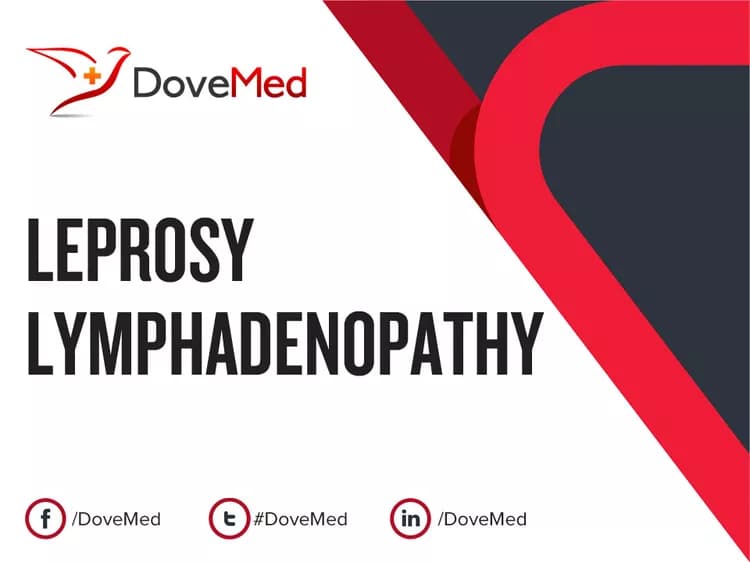What are the other Names for this Condition? (Also known as/Synonyms)
- Enlarged Lymph Nodes due to Leprosy
- Leprosy causing Enlarged Lymph Nodes
- Leprosy Lymphadenitis
What is Leprosy Lymphadenopathy? (Definition/Background Information)
- Leprosy Lymphadenopathy is the inflammation and enlargement of lymph nodes due to underlying Leprosy, which is caused by a bacteria
- Leprosy is a chronic infection caused by a rod-shaped bacterium Mycobacterium leprae. Children are generally affected by this disease more than adults
- The signs and symptoms of Leprosy Lymphadenopathy include enlarged lymph nodes (of the groin and head and neck region) that are not painful. However, Leprosy infection can affect the peripheral nerves, skin, upper respiratory tract, eyes, nose, and nasal mucosa, resulting in skin lesions, deformities, and disfigurement
- Complications associated with Leprosy (resulting in Lymphadenopathy) include disfigurement of body parts (affecting the nose, loss of fingers and toes) and even blindness
- Antibiotics are used in the treatment of Leprosy and an early diagnosis and treatment is crucial for a better prognosis. The prognosis of Leprosy Lymphadenopathy generally depends upon the severity of underlying signs and symptoms due to Leprosy infection
- The only way to prevent Leprosy and the associated Leprosy Lymphadenopathy is to avoid close physical contact with untreated, affected individuals
There are two types of Leprosy namely:
- Tuberculoid Leprosy or Paucibacillary Leprosy: It is a mild form of Leprosy that presents red patches of skin on the trunk or extremities, accompanied by a decrease in ‘light-touch’ sensation in such patches
- Lepromatous Leprosy or Multibacillary Leprosy: This is a more severe form of Leprosy with skin rashes that appear on the elbows, knees, buttocks, face, ears, and wrists
Who gets Leprosy Lymphadenopathy? (Age and Sex Distribution)
- Leprosy Lymphadenopathy develops due to underlying Leprosy that affects children more than adults
- No gender, racial, or ethnic preference are noted for Leprosy
- However, Leprosy is more prevalent in the following regions and nations:
- Indian subcontinent
- Brazil
- Certain parts of Africa such as Tanzania and Mozambique
- Madagascar
What are the Risk Factors for Leprosy Lymphadenopathy? (Predisposing Factors)
The main risk factor for Leprosy Lymphadenopathy is the underlying Leprosy infection. The risk factors include the following individuals, who have the highest risk:
- Children
- People living in countries with temperate, tropical, and subtropical climate
- Household contact with Leprosy-affected individuals
- Individuals who are immunocompromised
- Those living in overcrowded conditions
- Healthcare personnel who administer to the Leprosy-affected
It is important to note that having a risk factor does not mean that one will get the condition. A risk factor increases ones chances of getting a condition compared to an individual without the risk factors. Some risk factors are more important than others.
Also, not having a risk factor does not mean that an individual will not get the condition. It is always important to discuss the effect of risk factors with your healthcare provider.
What are the Causes of Leprosy Lymphadenopathy? (Etiology)
- Leprosy Lymphadenopathy is caused by the bacteria Mycobacterium leprae, which belongs to the family of mycobacteriaceae
- Leprosy is a contagious condition that spreads through infected respiratory droplets mainly affecting the skin, nerves, mucous membranes, and other body parts
What are the Signs and Symptoms of Leprosy Lymphadenopathy?
The signs and symptoms of Leprosy Lymphadenopathy may include:
- Lymphadenopathy or enlarged lymph nodes that may involve lymph nodes all over the body
- The swollen lymph nodes can be very large in size; enlarged lymph nodes in Lepromatous Leprosy are much larger than in Tuberculoid Leprosy
- However, mostly the lymph nodes in the groin (inguinal), head and neck region, and armpits (axillary) are involved
- The swollen lymph nodes are generally painless
- Rarely, lymph node enlargement may be seen without skin or nerve symptoms
The associated signs and symptoms of Leprosy depend upon the Leprosy type and may include:
Symptoms of Tuberculoid Leprosy:
- One or two red patches start appearing on the trunk or extremities along with a decrease in ‘light-touch’ sensation on such patches
- Skin stiffness and dryness
- Loss of fingers and toes
- Skin lesions with definite sensory loss, with or without thickened nerves
- Eye defects that may result in blindness
- Severe pain
- Muscle weakness in the hands and feet
Symptoms of Lepromatous Leprosy:
- Rashes start appearing on the elbows, knees, buttocks, face, ears, and wrists
- Thinning of eyebrows and eyelashes
- Thickened skin on the face
- Nasal stuffiness
- Nose bleeding, collapsing of the nose
- Swelling of the lymph nodes in the groin, armpits, and other areas; there can be a significant enlargement of the lymph nodes (massive lymphadenopathy)
How is Leprosy Lymphadenopathy Diagnosed?
The diagnosis of Leprosy Lymphadenopathy may include:
- Complete evaluation of medical history along with a thorough physical exam. In most cases, only a physical exam is sufficient for the diagnosis
- Molecular methods such as polymerase chain reaction (PCR)
- To confirm the diagnosis, a biopsy of the lesional tissue can be done, in which a small piece of tissue is taken and sent to a laboratory for examination under the microscope by a pathologist
In majority of the cases, a lymph node biopsy is not performed for Leprosy Lymphadenopathy. However, if the signs and symptoms persist despite suitable treatment, then a biopsy may be undertaken to rule-out other causes of swollen glands (such as a lymphoma).
In case of a lymph node biopsy, the following information may be noted:
- Lymph node biopsy: A lymph node biopsy is performed and sent to a laboratory for a pathological examination. The pathologist examines the biopsy under a microscope. After putting together clinical findings, special studies on tissues (if needed) and with microscope findings, the pathologist arrives at a definitive diagnosis. The pathologist may use special techniques, such as immunohistochemistry stains, to help reveal the presence of the pathogen
- The lymph node biopsy may be performed through any of the following procedures:
- Fine needle aspiration biopsy (FNAB): A device called a cannula is used to extract tissue or fluid from the lymph nodes
- Lymph node core biopsy of the enlarged lymph nodes
- Lymph node open biopsy of the enlarged lymph nodes
Many clinical conditions may have similar signs and symptoms. Your healthcare provider may perform additional tests to rule out other clinical conditions to arrive at a definitive diagnosis.
What are the possible Complications of Leprosy Lymphadenopathy?
The complications of Leprosy causing Lymphadenopathy may include:
- Loss of fingers and toes due to loss of sensation: Generally, the patients are unaware of the trauma to their hands and feet; repeated trauma results in the loss of fingers and toes
- Disfigurement, such as complete erosion of the nose
- Blindness
- Erectile dysfunction and infertility
- Kidney failure in severe cases
How is Leprosy Lymphadenopathy Treated?
Antibiotics are the mainstay of treatment for Leprosy Lymphadenopathy, which can help bring about a complete cure. Usually, combinations of antibiotics are given to destroy the bacteria that cause the underlying Leprosy.
- The combination depends on whether Leprosy is the paucibacillary type or multibacillary type. This is known as multi-drug therapy or MDT and the treatment may range from a period of 6 months to 2 years
- A variety of antibiotics are available for treatment of Leprosy
Surgery may be used as a treatment tool for Leprosy and may involve:
- Surgical reconstruction of the disfigured face and body extremities
- Cosmetic surgery to help correct some of the facial defects
- In extreme cases, some affected parts (finger or toes or limbs) may have to be amputated
- Nerve surgery can also help bring about better motor function and improved sensation in the affected parts or limbs
- Physiotherapy may be provided to regain muscle control, control of the affected fingers/toes
How can Leprosy Lymphadenopathy be Prevented?
- The preventative measures for Leprosy Lymphadenopathy includes reducing the risk of bacterial transmission by avoiding close physical contact with the infected and untreated individuals
- Currently, vaccines are not commercially available to provide protection against Leprosy
What is the Prognosis of Leprosy Lymphadenopathy? (Outcomes/Resolutions)
The prognosis of Leprosy Lymphadenopathy is based on the severity of the underlying Leprosy infection.
- Early diagnosis and treatment of Leprosy is crucial for an optimum outcome
- Proper treatment and follow-up can enable individuals to lead a better quality of life
Additional and relevant useful information for Leprosy Lymphadenopathy:
General information on lymph nodes:
The lymph nodes are part of one’s immune system. The lymph nodes are present throughout the body, usually in groups. In normal healthy adults, one cannot feel (see or touch) the lymph nodes readily. However, if they are enlarged, they can be felt either by the individual himself/herself or by the healthcare provider.
Enlarged lymph nodes can occur in both benign and malignant conditions. Hence, the cause of enlarged lymph nodes should be evaluated. If no obvious cause for enlargement of lymph nodes is found, then the possibility of a lymph node malignancy should be ruled out.
In a majority of individuals, a lymph node swelling is caused by a benign process such as an inflammation or infection. In many cases, swollen lymph nodes are part of other signs and symptoms. This can help a healthcare provider arrive at a list of follow-up tests and ensure an accurate diagnosis. Superficial enlarged lymph nodes can be felt by the healthcare provider through palpation. Enlarged lymph nodes deep in the body are often detected by radiological studies such as X-rays, ultrasound scan, CT and MRI scans.
Some enlarged lymph nodes can be painful, while others may be painless. Depending upon the underlying cause, enlarged lymph nodes can be localized to a particular area of the body, or they can be generalized, meaning that they are present throughout the body.
Related Articles
Test Your Knowledge
Asked by users
Related Centers
Related Specialties
Related Physicians
Related Procedures
Related Resources
Join DoveHubs
and connect with fellow professionals


0 Comments
Please log in to post a comment.